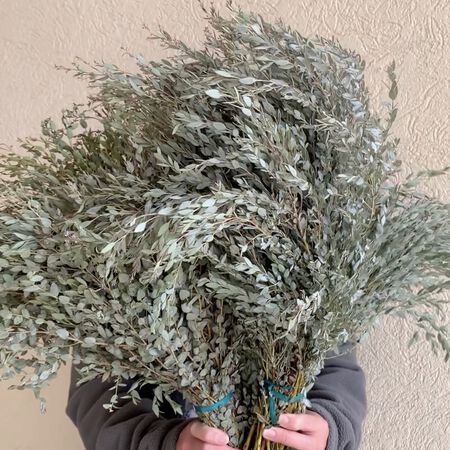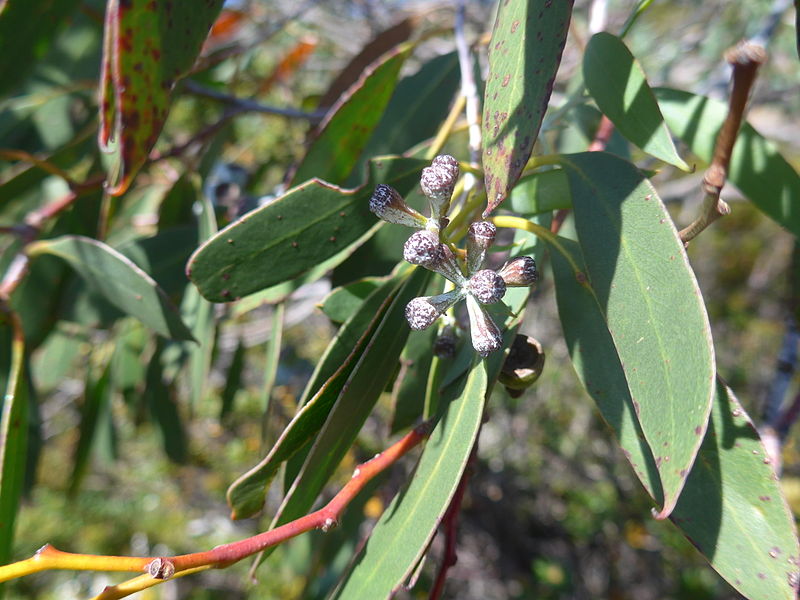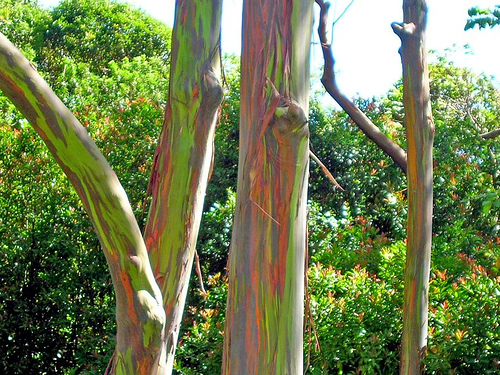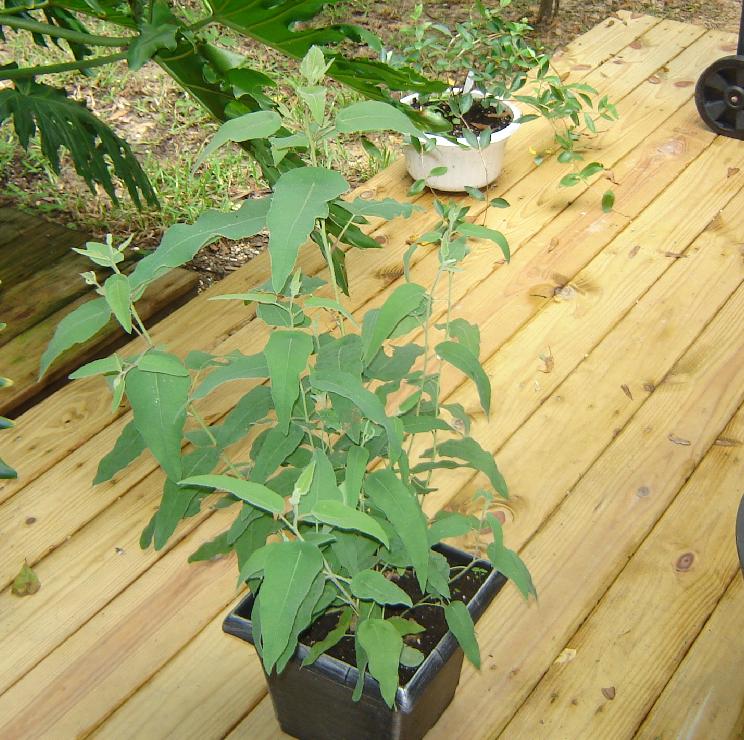Eucalyptus seeds from around the world.

It is the preferred variety for professional cutflower production.Unlike many Eucalyptus, it retains is juvenile rounded foliage into maturity. Highly scented, the leaves and steams are covered in a white, waxy powder. In the fall and spring, it has abundant clusters of creamy-white flowers among the foliage. Versatile, deer, and drought resistant, it makes a lovely specimen tree for a smaller garden to attract birds. Baby Blue can be used in patio gardens and containers and is commonly used in coastal gardens, informal or cottage gardens. Grows 15-25 feet tall and hardy for zones 7 and higher outside, but can be container grown about anywhere as long as it gets warmth and bright light.

A shrubby small Eucalyptus that can reach to 12 feet tall with small rounded spade-shaped, gray-green juvenile leaves flushed a pale purple that mature to a leaf that is green with a curved boomerang shape. If left to mature, in spring to summer appear reddish orange caps that open to expose white flowers. This plant can also be cut hard every few years to maintain it as a medium sized shrub to 4 feet tall and to promote the fine textured and aromatic juvenile growth that has become very popular in the California cut foliage market. Plant in full sun to light shade. Irrigate occasionally to infrequently. Hardy to about 23 degrees F but can resprout when top growth frozen - root hardiness not known. A nice fine-textured shrub for the garden and for cut foliage - it reportedly looks good up to 2 weeks in the vase.
NOTE: These are very tiny seeds, the smallest Eucalyptus seeds we have ever seen, good germination ,but handle carefully.

The blue green heart shaped foliage has a wonderful peppermint fragrance. In summer, it bears a profusion of creamy white flowers in clusters that stand out against the foliage.
It will grow to about 35 feet or taller and does well in zones 7-10.

Juvenile foliage consists of opposite rounded silvery bluish-green leaves (to 2" long) resembling large coins, hence the common name of silver dollar tree. Foliage is aromatic. Small white flowers rarely appear on juvenile trees or container plants. Foliage stems are frequently used by florists in fresh flower arrangements. Hardy for zones 8-11.

Grown mostly in tropical settings. Winter hardy to USDA Zones 10-11 where this tree will grow well in rich, medium to wet soils in full sun. Intolerant of frost.

Before walking in the woods, I will pick a few leaves, crush them and put them under my cap, this works very well.
Commonly known as Lemon Bush. This aromatic plant starts easily from seed. When grown in a container, it only reaches 3 to 4 feet tall. No matter where you live, you can grow this lovely plant from seed in your own home and enjoy the fresh lemony fragrance. Its fresh and lemony aroma is uplifting and simply brushing the leaves will release more fragrance that will remind you of the citronella candles sold to repel mosquitos. Outside in warm zones, it will grow into a small tree, but is most commonly grown as a container plant in cooler zones. It produces sword-shaped gray-green leaves, tiny white blooms, and a bit of red fall foliage change. For growing indoors, find a nice container and grow from seed in a bright window. It can also be grown outdoors, but bring it in before the first frost to winter it indoors.
Oil from the leaves is applied to the skin as a medicine and insect repellent. Citrodora Ecalyptus oil is used for preventing mosquito and deer tick bites. It is also an ingredient in chest rubs used to relieve congestion. The oil has a strong fresh citronella-like odor with a sweet balsamic undertone. Very effective insect repellent due to a higher citronellal content than citronella ( which is commercially harvested from citronella grass, a different type of plant and is used in many insect repellants ).
Eucalyptus Citriodora has good branching and makes an attractive container plant with wonderful citrus-spice fragrance. It is actually an herb, and its 3-inch leaves are bold and dramatic indoors, and the white summer blooms add another interesting dimension to this versatile plant.
The plants are winter hardy in USDA zones 8-11, but can be grown as a container plant or annual in any zone.
Trees bloom in winter in outside in warm zones, in the greenhouse they bloom in late winter to early spring. The white blooms are not very distinctive. The blooms are followed by woody urn-shaped capsules about 3/8 of an inch wide.
Eucalyptus citriodora need full sun with a well-drained soil mix for container growing. Most gum trees grow in very nutrient poor soils and fertilizer is not needed; however container plants should be feed once during the spring. To control the size of the trees in containers, do all pruning and repotting in late to early spring after flowering.
How to start seeds and grow:
Start seed indoors into a starter tray. ( We like to leave seed packet in the fridge for 30 days before sowing, this seems to enhance the germination ). Press the seed into the soil and cover lightly, about twice the thickness of the seed. Keep the seeds moist by watering from underneath. Once the seedlings are 4 to 5 inches tall, transplant into containers. Start with a 1 to 2 gallon container with potting mix and after a year or so, transplant into a larger 3 to 5 gallon container. Feed monthly during the growing season with water soluable plant food or mix granular 5-10-10 fertilizer with micronutrients into the soil each year.

Leaves are stalked, lanceolate to broad lanceolate, glossy dark green. White flowers appear in mid autumn to late winter . E. grandis is found on coastal areas and sub-coastal ranges from Newcastle in New South Wales northwards to west of Daintree in Queensland, mainly on flat land and lower slopes.
The bark is thin and deciduous, shedding in strips to expose a smooth surface marked with flowing patterns of silvery white, slaty gray, terra cotta, or light green. Occasionally a "stocking" of light-gray, platelike or fissured bark persists over the basal I to 2 m (3 to 6 ft) on the trunk.
Rose gum is one of the most important commercial eucalypts, with more than one-half million hectares (1.3 million acres) planted in tropical and subtropical areas on four continents. Massive planting programs have been carried out in the Republic of South Africa and Brazil, and there are substantial plantings in Angola, Argentina, India, Uruguay, Zaire, Zambia, and Zimbabwe. In southwest Florida rose gum may be an emerging commercial species for plantations. It has been successfully tested for pulpwood and fuel; and its wood has potential for poles, pallets, veneer, and other products. In California, Hawaii, and Puerto Rico, rose gum appears in some species trials and landscaping. Cold hardy to about 32 degrees.
Eucalyptus Seed Germination Instructions ( Note: Please print these instructions for future use, seed packets do not include detailed germination instructions as size of packet label is limited ).
Seed germination of Eucalyptus generally falls within two categories: Those that need no pre-treatment and those that need chilling or cold stratification. Only those species that come from colder areas need the cold stratification process. Seed sourced from warmer climate areas do not need to be pre-chilled.
About 95% of Eucalyptus seed needs no
pre-treatment. Species of the "snow gum" and a few other
species found in colder areas provide a better germination rate
when they have been cold stratified. Those Eucalyptus species
we have found to respond to cold stratification are:
Amygdalina, coccifera, dalrympleana, debeuzevillei,
delegatensis, dives, elata, fastigata, glaucescens, goniocalyx,
kybeanensis, mitchellana, niphophila, nitens, pauciflora,
perriniana, regnans, stellulata.
Cold stratification of seed is a simple process. Using a filler like perlite, vermiculite or sand, take 2-3 times the volume of filler per volume of seed. If you are stratifying 1 teaspoon of seed, use 2-3 teaspoons of filler. Mix together and slightly dampen and place in the zip lock bag the seeds arrived in and date. Place this in the refrigerated section of your refrigerator - not your freezer! Generally 4-6 weeks of chilling is sufficient, although we have not shown any detriment to the seed by leaving it in for longer periods.
After the stratification process is
complete you can sow the seed at your convenience.
Don't try to separate the seed from the inert material, sow all
together.
Instructions for seed sowing: Eucalyptus seed is generally sold with chaff (inert material). Sow both seed and chaff on the surface of a pre-moistened media. Use a high quality seed starting mix that is not clumpy or full of bark, a premium seed starting mix is well worth the investment. Some prefer to create their own special perlite/sand mix, this does very well also.
Note, it is rumored that soaking seeds in Hydrogen Peroxcide will increase germination, we do not do this, but it seems to be a common practice with many growers.
Sow the seed (and chaff if so mixed) on
the surface of my pre-moistened perlite/sand mix. Cover the
seed no more than 1/16" with sand and then cover with
plastic.
Ideal germination conditions are around 68-72 degrees F with a
humidity of near 100%, but you will still get good results at
lower humidity levels. Average germination time is about 2
weeks, although some species will germinate faster and others
at a much slower rate, some taking 6-12 weeks.
Once germination has taken place, ideally, you should remove the container of seedlings and place it an an area of bright light and provide a lower temperature of 55-60 degrees F for several weeks. The lower temperature provides a stockier seedling. Higher temperatures tend to make seedlings stretch and they become weak and spindly.
Ideally, pick out the seedlings at the "true-leaf" stage for transplant. The "true-leaf" stage is not the same as the cotyledon leaves. When a seed germinates, generally 2 leaves will show - these are the cotyledon leaves. Additional growing time is needed for the "true-leaves" to form.
Once the seedlings are at the "true-leaf" stage, carefully pick out the seedlings and transplant into individual cells. Hold the seedlings by the leaves, not the stem to prevent damage to the main stem. Carefully water the seedlings in and monitor media moisture. You don't want them soggy wet nor too dry, a slightly moist balance is what the seedlings need. Grow on in pots for the first year.

